Continued from yesterday”¦The next stop was a quick tour of the Apollo Gallery next door to the Italian Gallery. This is ridiculously opulent room, with carved and gilded walls and ceilings. On the walls are portraits of various important people and on the ceilings are more statues. There is so much gilding that the walls and ceiling look to be solid gold from a distance.
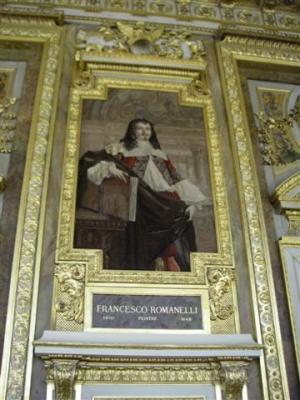
This room was full of fancy things. The centerpiece are a couple of royal crowns, one of them completely encrusted with giant precious stones. They are so big that they look fake. Most of the collection of especially fancy porcelain ware, with lots of cups and mugs and serving pieces. Many have very cool and unique designs. There were also a lot of fancily decorated small storage boxes and a few pieces of jewelry that belonged to the queen.
The next gallery we went through was the Bronze and Precious Objects, and we are not sure, but we think they are mostly Greek pieces, with some Etruscan and Roman pieces. It is a similar collection of things to the Bronze Room in the Etruscan Museum at the Vatican. There are statues ranging in size from little figurines to larger than life pieces, decorative mirrors, armor and weapons, cookware, serving pieces, jewelry, and so forth.
We headed down a different staircase that led us to the Greek Antiquities exhibit. This is a series of rooms featuring mostly marble sculptures. We walked through the whole gallery, and we have to say that the pieces on exhibit are phenomenal. We have seen a zillion Greek sculpture exhibits now, and this collection, while by no means the biggest, is probably the best we have ever seen, both in terms of the quality of pieces and the variety of subject matters. It is a pity that this collection is in France, not Greece. The largest room of the exhibit is decorated in a Greek theme, with marble floors, columns with fancy tops, and lots of crown moulding. The numerous other small rooms have pink marble walls and a plain ceiling. The big ooh and aaah piece within the gallery is the famous Venus de Milo, which is in the first picture. The second picture is of another statue we liked. You can also see a little bit of some of the other statues in the background.

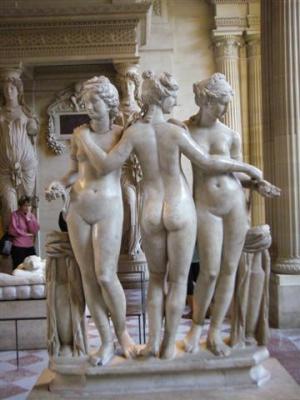
The next thing on the must see list was Napoleon III’s apartment. We went back upstairs to the gallery of 17th and 18th century objects of art. This is a long series of rooms with an eclectic display. There is a lot of furniture. There are tapestries, stained glass, mugs, armor, weapons, chests, clocks, watches, sculptures, ceramics and a whole lot more. Everything on exhibit is especially decorative, most stunningly beautiful. These have to be the coolest mugs of all time.
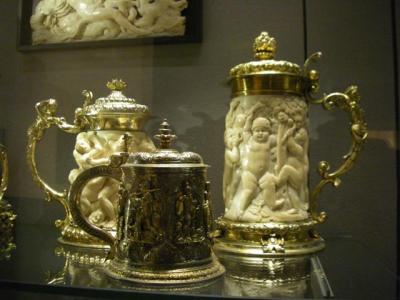
This gallery led us into Napoleon III’s apartment. Keeping in the tradition of all the previous kings, Napoleon ordered a wing to be added to the Louvre shortly after coming to power. This wing was built between 1852 and 1857. And yes, at that point in time, part of the Palace was being actively used as a museum, but since there was still a relatively small display of art, only a small percentage of the palace was utilized in this capacity. Napoleon set up house in his new wing.
We’re not sure what we were expecting to see. The apartment is quite feminine in décor. Many rooms have flowery wallpaper and frilly decorations. There is only one “guy looking” room that is a study with dark wood paneling and more masculine décor. There is a big formal living room and a huge formal dining room, and a few smaller rooms. There are heavy drapes, expensive looking rugs and furniture, lots of flashy chandeliers and carved walls with plenty of gold trim. It is definitely opulent, just like the rest of the palace was. There is a room with an enormous gold topped canopy bed that is at least 8 feet tall, but we are unclear if that was part of Napoleon’s apartment or if it is part of the 19th Century Objects de Art display on the other side of Napoleon’s apartment. It is right on the border of the two.
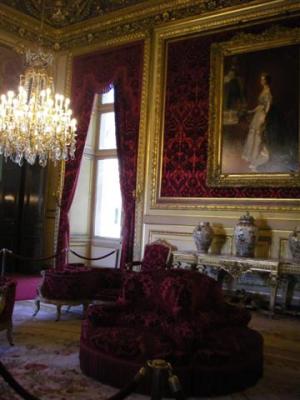
The 19th Century Objects d’Art, the July Monarchy and the Restoration are all small exhibits off Napoleon’s apartment. The three blurred together for us. There was a lot of expensive furniture, some jewelry, some paintings and tapestries, some bric a brac. Uh oh, our brains are getting full. Won’t be able to last much longer from here.
We headed up the stairs to the 16th century paintings from the Netherlands, 15th & 16th century German paintings, and 14th 17th century French paintings. All three galleries are fairly small, and everything we saw in them is a blur to us. There were only a few paintings that we can clearly recollect seeing. One was of the Rhodes harbor and the huge Colossus statue that supposedly once stood over the harbor entrance.
Since we were no longer absorbing anything, it was time to take a break. We went down to one of the restaurants and had lunch. We started chatting with the ladies at the table next to us. It turns out they were in town for a food convention, one of the biggest conventions in the world. Oh. No wonder we couldn’t find a hotel room. We guess it was silly to assume there wouldn’t be a huge convention in town the exact same days we decided to visit.
After lunch, we went down to the ground floor to check out the Mesopotamia exhibits. For the most part, it was the usual assembly of artifacts, including jewelry, clay molds for casting metal, and artwork of assorted sizes, ranging from tiny figurines to huge pieces. There were quite a lot of expressive figurines, both animal and human, that remind us of the Carthagian art we had seen in Tunis. We really like the expressive pieces, they look almost cartoonish and looking at them almost makes you feel happy.
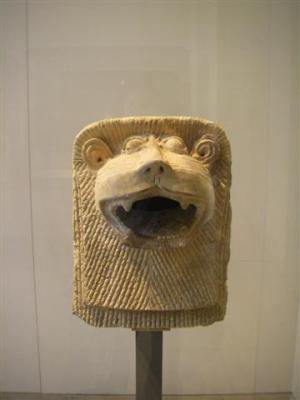
There is one cabinet filled with many little naked women figurines, all about the same height, all standing in the same position and holding a breast with each hand. What made it of interest is the variety of shapes to the women. They had everything from super skinny figures to extremely obese women, and some women had big breasts and some had small breasts. We wonder if they were made to portray specific women?
What was unique about this exhibit is that they have transported whole entire walls from ancient palaces/temples. Eric is standing in front of the “Winged Bull” which protected the palace of Sargon II. The second photo is the “Capital of Apadana”, another famous piece from this exhibit. In the background you can see a big mosaic covers the wall.
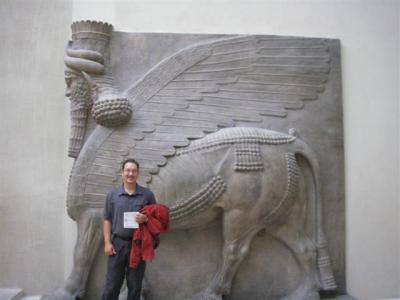
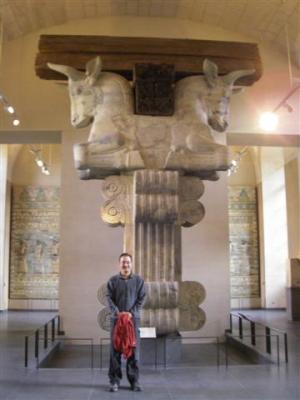
We made it through about ¾ of the exhibit before we decided we were museumed out and needed to go. As we were leaving, we decided to make a quick walk through the gallery next to Mesopotamia, 18th to 19th Century French Sculpture. They have some unique, creative and beautiful pieces in there. Ones that we really liked were a soldier giving an infant a drink of water, a happy reggae looking dude with a musical instrument that looks kind of like a ukulele, and a girl whispering secrets into a statue’s ear. We didn’t stay long, but we were impressed with the exhibit. An art class was meeting in there, and each student was plopped down on the floor in front of a statue, sketching it. Once again, how cool to go to class at the Louvre.
We were sad that we had only managed to see about ¼ of the museum, but now that we’re writing about it, we guess we really did see a lot. To do the Louvre right, you’d have to go over four days, visiting one floor per day.
We headed back to hotel to freshen up before dinner with Louis (the Louis from Scari). When we had last seen Louis in Lipari, he had said he was scheduled to go on a business trip to Paris at approximately the same time we planned to be there, and to call him when we knew exact dates. It turns out that his business trip overlapped exactly with our visit, which we thought was amazingly lucky. Of course, it turns out he was attending the food conference.
Louis had us meet him at Paris’s equivalent of Wall Street, a classical style building only a few blocks from our hotel. We took us to dinner at a near by restaurant that serves traditional Southern French dishes. They had a big variety of foie gras on the menu to choose from. We got a traditional foie gras, which Louis told us is partially cooked, then canned. It was served with gelee au Monzabillac, which looked like small pieces of orange jello but was savory instead of sweet and didn’t have a lot of flavor. We also got what Louis called a “fresh” foie gras, which is a fresh liver cooked to order. It was lightly fried so it is hot, but rare, and came with prunes and a salad. It still has a soft texture and light taste, but there is no mistaking this one to be anything other than a meat. The two were flavored differently. Both were good, and the flavors were distinctly different. We had a couple different sweet white wines to accompany the foie gras. This made Christi happy. She prefers sweet, white wines, but they usually only seem to be served with dessert.

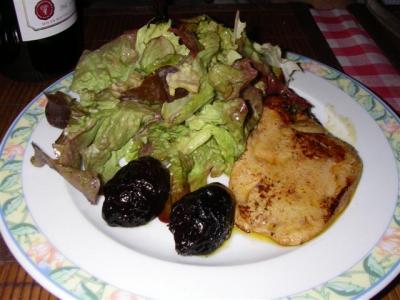
Christi ordered duck in an apricot sauce. The sauce was light and the duck was tender. Eric ordered a traditional southern dish called cassoulet, which is mostly beans cooked with cabbage in a gravy, topped with a duck leg and a sausage. It is a hearty, stick to your ribs kind of meal.
After dinner, Louis took us for a walk and pointed out some more sights. We went by the Opera House, which he said is built on top of a man made water reservoir. We also went by Victory Square, a round town square that was one of the spots within Paris that helped to inspire Haussmann’s vision of what the city should be. We went inside a covered shopping arcade, basically a small mall. Louis showed us how to pick out older buildings that survived Haussman’s city remodel. Basically, if they are plain and aren’t perfectly lined up with the street front, they are pre-Haussmann. We had a nice time with Louis and we’re glad we had the opportunity to meet up with him again, this time under more pleasant circumstances.

No no no no no! “Eric ordered a traditional southern dish called cassoulet, which is mostly beans cooked with cabbage in a gravy, topped with a duck leg and a sausage.”
You need to go to Toulouse for REAL southern french cassoulet! No cabbage involved!! Duck confit, with duck sausage, and white beans – i think there may be some bread crumbs in it or on top and i’m not sure but maybe even lardons or at least duck or goose fat that makes it so freaking delicious it’s ridiculous!! cabbage? Egads! I’m drooling, I must have cassoulet – I must. =( I need to go back to Toulouse!
This entry about The Louvre epitomises why you are the Queen of Blogs Christi! Very eloquent, and truly inspirational. N40#65 will be visiting Paris later this year and you have brought a museum to life for us all.
I doubt if you really understand just how much pleasure you give to so many people with your writing. I, like many others I imagine, arrived to share your travels as boaters, but you have expanded all our horizons enormously. Thank you for giving us that.
Very best wishes to you both,
Colin
Yeah,I agree